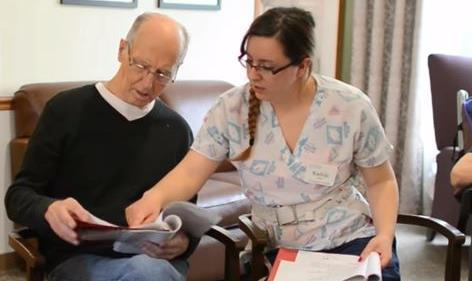SHARING CAREGIVING RESPONSIBILITIES
F.A.S.T TO END STORKES









Engaging in fitness activities that are enjoyable can increase the likelihood that a person will remain committed to routine exercise.
In addition to being fun, swimming is an exercise that benefits the entire body. It’s also ideal for people of all ages, as the buoyancy of water reduces the strain on muscles and joints.
Healthline reports that an hour of swimming burns almost as many calories as running, without all the impact to the bones and joints.
Many people who commit to swimming each week may have no problem getting the recommended 150 minutes of moderate activity or 75 minutes of vigorous activity each week recommended by various health organizations.
Here are some of the ways swimming is good for your body.
• Engages the entire body: Swimming works just about all the muscles of the body. Various swimming strokes can enable a person to focus on certain muscle groups, if desired.
• A thorough cardiovascular workout: Swimming increases heart rate without stressing the body. The fitness level can be customized and gradually built up so that one can increase strength and endurance.
• Reduces body fat: Swimming can help many people slim down. According to Harvard Medical school, a 155-pound
person can burn about 432 calories swimming versus about 266 calories walking at a moderate pace for the same duration of time.
A recent study published in BMC Sports Science, Medicine and Rehabilitation revealed that 16 weeks of swimming led to significant reductions in body fat and BMI among those studied.
• Improves heart health: Research has linked swimming to a reduction in blood pressure and additional benefits related to improved cardiovascular health.
• Enhances lung volume: Swimming involves deeper breathing and can strengthen the muscles involved with respiration, says Everyday Health.
• Can improve quality of life: Studies have shown that older adults who swim regularly may experience decreased rates of disability and improved quality of life.
Swimming helps to improve or maintain bone health, particularly among postmenopausal women. Water-based exercise also is low-impact and builds strength.
• A mental health boost: The Centers for Disease Control and Prevention notes that swimming can improve mood in both men and women. Swimming may decrease anxiety, and exercise therapy in warm water can improve symptoms of depression.
These are just some of the health benefits associated with swimming.
(METRO CREATIVE)
A publication of Southern Lakes Newspapers LLC 1102 Ann St., Delavan, WI 53115 (262) 728-3411
EDITOR IN CHIEF: Heather Ruenz
PAGE DESIGNER: Jen DeGroot
CREATIVE DIRECTOR: Heidi Schulz
ADVERTISING
DIRECTOR: Vicki Vanderwerff FOR ADVERTISING OPPORTUNITIES: Call (262) 728-3411
above: There are several ways swimming is good for your body such as enhancing lung volume, improving heart health and reducing body fat. It’s safe for people of any age and in addition to the physical benefits, can improve your mood, decrease anxiety and ward off depression, experts say.
STOCK PHOTO Living Senior

If the idea of eating healthy makes you think that you have to give up all of your favorite foods, you’re in the majority. While it is true that certain foods may not make the healthiest choices, substitutions can add nutritional value to some beloved yet traditionally unhealthy dishes. The United States Department of Agriculture Dietary Guidelines for Americans emphasizes the need for people to reduce the amount of added sugar, sodium and fat they consume, all the while increasing fiber consumption. Subtle changes may make it possible


There are several substitutions to keep in mind when aspiring to eat healthier. Suggestions include using seasonings and fresh herbs rather than salt to enhance flavor and swapping out sugar by using maple syrup. STOCK PHOTOS Living Senior
to boost beneficial nutrients and reduce the caloric load of various dishes.
Here are some simple substitutions to keep in mind when aspiring to eat healthier.
Swap: Applesauce, mashed avocado or mashed banana
Plant-based alternatives can add moisture to baked goods without increasing saturated fat.
Even swapping out a portion of the butter or oil with these alternatives can make the item healthier.
Swap: Different cooking methods
Baking, broiling, grilling, or roasting can produce delicious results.
Many people utilize air fryers that employ convection to simulate frying without the need for all the oil frying requires.
Swap: Maple syrup or mashed dates
Many people think they need to give up on sweets when eating healthy. Sugar is an added ingredient in so many foods, so reducing consumption can help.
In addition to slashing the amount of sugar recommended for recipes, swap out sugar with maple syrup, honey or even
mashed fruits. These are better options than refined sugars.
Swap: Herbs and other spices
Omit half of the salt recommended in a recipe. Replace the salt with spices or herbs to add flavor.
It’s also worth noting that nutritional yeast can add a salty umami flavor to many dishes as well as providing additional nutrients.
Swap: Brown rice, quinoa or couscous
Add additional fiber and/or protein to dishes by swapping processed white rice with whole grains.
Similarly, swap regular pastas with whole grain, and white bread with whole grain bread.
Swap: Almond meal or milled flaxseed
Breadcrumbs impart flavor and texture, but they add calories with no nutritional value. Consider breading foods in almond meal or milled flaxseed to provide omega-3 fatty acids.
Substituting certain ingredients for others and embracing new food preparation techniques can add nutritional value to some beloved foods.
(METRO CREATIVE)
Family caregivers are unsung heroes. Such individuals typically provide vital services to their loved ones who cannot fully care for themselves, and they often do so without compensation.
Data from the U.S. Bureau of Labor Statistics indicates the prevalence of family caregivers across the country. According to the BLS, 14 percent of the population, which equates to roughly 37 million people, provide unpaid eldercare across the nation.
Unpaid caregivers also provide vital services in Canada, where the Canadian Institute for Health Information reports such individuals provide an average of 17 hours of unpaid care each week (26 hours for those who care for seniors with dementia).
Caregiving for a family member can take a toll that affects caregivers’ physical and mental health.
According to the Centers for Disease Control and Prevention, caregivers are at increased risk for developing multiple chronic diseases since many neglect their own health needs while caring for others. In addition, roughly 15 percent of caregivers who participated in a CDC survey reported experiencing 14 or more mentally unhealthy days in the past month.
The physical and mental toll of caregiving underscores how important it can be for families to find ways to share caregiving duties.
Though each situation is unique, the National Institute on Aging offers the following advice to families as they seek to share the responsibility of caring for a loved one in need.
The NIA recommends families discuss caregiving needs as early as possible and ideally before an emergency situation arises. If possible, the person in need can participate in this conversation and help to calmly discuss which services are wanted and needed.
If a loved one is diagnosed with a condition in its early stages, such as dementia, families can then work together

to identify the level of care required in the immediate future and potentially down the road should the condition worsen.
The primary caregiver will be the individual who accepts the bulk of the daily responsibilities of caregiving. Identifying this person early, ideally before a primary caregiver is even needed, can limit confusion should the day come when the individual needs daily care.
The caregiving team can discuss each person’s skills and how they can be used to take care of the individual in need. This can be particularly useful when assigning specific tasks.
For example, a caregiver who works in the medical field may be most qualified to speak to medical staff about their loved one’s
condition, while another who works in the financial sector may be tasked with managing a loved one’s bank accounts and ensuring bills are paid on time.
A caregiving team is just that: a team. As noted, caregiving can take both a physical and emotional toll, so it’s important that everyone, and particularly the individual chosen as the primary caregiver, receive routine breaks to ensure everyone can take care of themselves.
It’s important that a caregiving team maintain a degree of flexibility to account for the physical and mental challenges caregivers may encounter as they tend to a loved one in need.
Sharing the responsibility of caregiving can ensure caregivers and their loved ones in need are not overwhelmed by the challenges they might confront each day. More information about caregiving can be found at nia.nih.gov.
(METRO CREATIVE)
The National Institute on Aging offers several pieces of advice to families as they seek to share the responsibility of caring for a loved one in need. Among other benefits, sharing the responsibility can keep the caregivers and their loved one from feeling overwhelmed.




Love,
with
• High Caregiver to Resident Ratio
• Exclusive MOSAIC Connections
Training; a required advanced dementia and engagement education system featuring the Virtual Dementia Tour
• Personalized Life Engagement Programming; featuring MOSAIC Therapies of Cognitive Stimulation, Creativity, Exercise, Community Participation and more!
• Medication Management
• Secured Entrance and Exits
• Incontinence Care
• Behavioral Expression Management
• Electric Charting System
• On-site Beautician, Dental Care, Podiatry, Physician*, Home Health Therapies and Hospice Care
• Unique MOSAIC Dreams Program!
Beloit | Clinton • 608-295-2764 • www.azuramemory.com Call today to witness the Azura










A well-rounded fitness regimen for people of all ages should be made up of various components, including strength training. Strength training – or weight training – can be mischaracterized as an activity best suited to individuals looking to bulk up. However, strength it’s about much more than maxing out on the bench press.
According to the Centers for Disease Control and Prevention, musclestrengthening activities reduce the risk of falls and fractures, which is a notable benefit for adults of all ages, and particularly so for adults nearing an age where they might experience mobility issues.
The National Institute on Aging notes that studies indicate as many as three in 10 individuals over age 70 experience mobility issues that affect their ability to walk, get up out of a chair and climb stairs.
Adults in middle-age, and even those for whom retirement remains farther in the distance, can prevent such issues by incorporating strength training into their workout regimens. Novices who want to do just that can heed these tips to avoid injury as their bodies acclimate to strength training.
Fitness facilities typically have highly trained and knowledgeable personal trainers who can teach members the proper techniques in regard to various strength-building exercises.
Many facilities offer one or two free personal trainer consultations to new members, and it’s best that people of all ages take advantage of such benefits.
Even if sessions are not complementary, working with a personal trainer is a great way to learn proper form, which is vital to avoiding injury. Furthermore, they can be helpful in creating a routine that’s safe and adjusts over time in line with progress.
And if you have a home health nurse – or physical therapist, for those undergoing rehabilitation – should also be able to assist with safe ways to increase strength.
The Mayo Clinic notes that cold muscles are vulnerable to injury, so individuals should never begin weight

training sessions without a pre-workout warmup.
The fitness experts at Gold’s Gym note that 10 minutes of light cardiovascular exercise on a treadmill, stationary bike or elliptical machine before strength training can increase range of motion, decrease risk for injury and help to create more change in muscles.
If necessary, include a foam roll and stretch exercise in your warmup, targeting the muscles that will be used during the ensuing weight training session and any muscles that seem particularly tight. Foam rolling each muscle for 20 to 30 seconds can help to loosen them in advance of a workout.
The adage “Rome wasn’t built in a day” is certainly applicable to weight training.
Initial weight training sessions should involve light weights as the body acclimates to a new workout and individuals master the form for each exercise.
Weight can be gradually increased as individuals acclimate to lifting weights, a process that the Mayo Clinic suggests can unfold over two to four weeks.
It’s important to keep in mind however, that each individual is different, so if it takes longer than four weeks to add weight, so be it. The key in the early days is to master the form and help the body adjust.
There are several ways seniors can work to avoid injury as their bodies acclimate to strength training. Suggestions include working with a home health care worker, physical therapist or personal trainer, starting with lighter weights and getting proper rest between workouts.
The Mayo Clinic notes that using momentum during a set can lead to injury because the goal is not to swing or lift the weights as quickly as possible.
Slow repetitions that take about two seconds to lift the weight and four or more seconds to lower it can reduce injury risk.
Another advantage of those slow repetitions is that it can activate muscle fibers in the targeted muscles, which makes strength training more effective over the long haul.
Rest is a vital part of a successful weight training regimen, and it’s especially important for novices to rest in between sessions. The Mayo Clinic recommends resting muscles for at least 48 hours.
Do not ignore sharp or shooting pain or assume it’s a natural byproduct of the transition to strength training.
Cease performing any exercise that causes such pain and consult your physician about what to do.
Weight training promotes long-term health, and beginners need not be intimated by hitting the gym to build strength.
(METRO CREATIVE)
By Dan Truttschel AMERICAN HEART ASSOCIATION
Every 40 seconds someone in the U.S. has a stroke, and 1 in 4 stroke survivors will have another one.
The American Stroke Association, a division of the American Heart Association, in honor of National Stroke Month, recently raised awareness about strokes, including steps that can be taken to prevent them.
Stroke is the fifth-leading cause of death and a leading cause of serious, long-term disability in the United States, despite stroke being largely preventable as well as treatable and beatable.
Consider the following statistics, according to the American Stroke Association:
• Each year, approximately 800,000 people in the U.S. suffer a stroke.
• Even though some people are at higher risk for stroke, like stroke survivors and people with unmanaged AFib (atrial fibrillation) or high blood pressure, anyone can have a stroke at any time.
• Recognizing the warning signs of a stroke and calling 911 immediately may make the difference between a strong recovery or long-term disability, survival or death.
• High blood pressure is the leading cause and controllable risk factor for stroke and heart disease. It’s important to know your numbers and work with a health care professional to control levels and manage risks.
Having a stroke puts you at higher risk for a second one. However, there are things you can do to reduce your risk, starting with identifying what caused your stroke and uncovering all of your personal risk factors.
Here are three ways you can act now to beat stroke:
• Learn how to spot a stroke F.A.S.T. If you see Face drooping, Arm weakness or Speech difficulty, it’s Time to call 911.
Every 40 seconds, someone in the U.S. has a stroke. It could happen on your street, in your workplace, at a store where you shop — anywhere. Your readiness to spot the stroke warning signs and call 911 could save a life or make the difference between a full recovery and longterm disability. That’s why it’s so important to learn the stroke warning signs and urge everyone you know to do the same.
The faster stroke is treated, the more likely the patient is to recover.
In fact, stroke patients who are treated with the clot-busting drug IV r-tPA Alteplase within 90 minutes of their first symptoms were almost three times more likely to recover with little or no disability.
In some cases, a procedure to remove the clot causing the stroke is also recommended. Nintey-one percent of stroke patients who were treated with a stent retriever within 150 minutes of first symptoms recovered with little or no disability.
The thing to remember is that stroke is largely treatable. It’s a matter of getting the right treatment, right away.
• Know your blood pressure numbers and keep them in a healthy range. High blood pressure is a leading cause and controllable risk factor for stroke and heart disease. Lowering your blood pressure reduces your risk of stroke.
• Prevent another stroke – If you’ve had a stroke, be a bold advocate for yourself by talking to your doctor about managing risk factors to help prevent a second one.
A stroke happens when normal blood flow in the brain is interrupted. When parts of the brain don’t get the oxygen-rich blood they need, those cells die.
Quick identification and treatment of stroke equals a higher chance of survival and recovery. Having a stroke puts you at a higher risk for a second one.
There are things you can do to reduce your risk, starting with identifying what caused your stroke and uncovering your personal risk factors.
A stroke can happen to anyone at any time. However, the burden and risk of stroke is higher among Black and Hispanic adults in the U.S. This is in part due to unmanaged risk factors including high blood pressure, obesity and diabetes.
A large majority of strokes can be prevented through education and lifestyle changes such as moving more, eating smart and managing conditions like AFib and high blood pressure.
There is never a bad time to become a bold advocate for yourself and others by learning the signs of a stroke and talking to your health care team to manage your risk factors.
Remember, a stroke is an emergency. If someone is having a stroke, they need to get medical attention right away.
Spot a stroke F.A.S.T.:
• Face Drooping – Does one side of the face droop or is it numb? Ask the person to smile. Is the person’s smile uneven?
• Arm Weakness – Is one arm weak or numb? Ask the person to raise both arms. Does one arm drift downward?
• Speech Difficulty – Is speech slurred? Is the person unable to speak or hard to understand? Ask the person to repeat a simple sentence, like “The sky is blue.”
• Time to Call 911 – If someone shows any of these symptoms, even if the symptoms go away, call 911 and get to a hospital immediately. Check the time so you’ll know when the first symptoms appeared.
Prevent stroke now, so you can be there later. For more information about strokes including prevention and recovery tips, visit stroke.org.

flow in the brain is interrupted. When parts of the brain don’t get the oxygen-rich blood they need, those cells die. The good news is many strokes are preventable as well as being treatable, if addressed early enough.

Preplanning your funeral is the only way to make sure your final requests will be fullfilled. Relieve your family from having to make decisions during an extremely stressful time. They’ll appreciate knowing your funeral is exactly as you had planned.
Learn more about Pathway,® a life insurance/annuity program that is used exclusively to fund funeral arrangements
Daniels Family Funeral Homes & Browns Lake Crematory Schuette-Daniels Browns Lake Crematory 625 S. Browns Lake Dr., Burlington, WI 53105 • (262) 763-3434 Polnasek-Daniels 908 11th Avenue, Union Grove, WI 53182 • (262) 878-2011
















Playing a round of golf is a great way to spend a morning, afternoon or early evening. That’s particularly true when the weather is warm and a golf course is soaked in sunshine and cooled down by warm breezes whistling through the surrounding trees.
Though many see golf as recreation, the sport can offer some notable health benefits.
The Royal and Ancient Golf Club of St. Andrews, which was founded in 1754 and has since grown from a small club to one with 2,500 members across the globe, published a recent golf and health report.
That report highlights research indicating the ways golf promotes both mental and physical health, and such evidence can make anyone feel better about spending a day on their nearest course.
With that in mind, individuals can consider these notable health benefits of playing golf the next time they’re thinking about visiting their local course.
Frustrated golfers who can’t master their short game may suggest otherwise, but a study published in the Scandinavian
Journal of Medicine and Science and Sports discovered a 40 percent reduction in mortality rates among 300,000 members of the Swedish Golf Federation.
That corresponded to an increased life expectancy of roughly five years and applied to golfers of all ages, genders and socio-economic backgrounds.
A summary of findings conducted by researchers at the University of Edinburgh and published in the British Journal of Sports Medicine recently found that golf can help prevent and treat a number of major chronic diseases.
Among the things it can assist is keeping at bay are diabetes, heart attack, stroke, depression, dementia, and cancers of the breast and colon.
That link probably has something to do with golf being a physical activity that encourages people to embrace a less sedentary lifestyle.
The Royal and Ancient Golf Club notes that additional studies have found that risk factors for heart disease and stroke, including high blood pressure, are reduced among people who play golf.
The Alzheimer’s Society reports that social isolation can increase a person’s risk for dementia by roughly 60 percent.
People who play golf tend to play in groups of two, three or four, and that social interaction can promote social interaction among people of all ages.
Social isolation also has been linked to additional mental health issues, including anxiety and depression, so activities like golf that encourage social interaction can help people safeguard their mental health.
A round of golf may be widely viewed as a recreational activity. However, a day on the links also provides some notable health benefits.
( METRO CREATIVE)
Individuals can consider notable health benefits of playing golf the next time they’re thinking about visiting their local course. Not only does it promote social interaction, but it can help combat illness and may even help people live longer.
STOCK PHOTOS Living Senior
One need not look long or far to be reminded of the importance of saving for retirement. Indeed, it’s hard to go a single day without encountering roadside billboards, television and streaming service advertisements, and/or promotional emails touting the retirement planning services offered by an assortment of investment firms.
If those adds seem ubiquitous, it’s for good reason, as saving for retirement is among the most important steps individuals can take as they look to ensure their longterm financial security.
Despite the widely accepted significance of retirement planning, studies indicate that many people are behind on saving and aware that they’re behind.
According to a recent survey from the online financial resource Bankrate, 55 percent of respondents

indicated they are behind on their retirement saving. In addition, a Gallup poll released in May 2023 indicated that just 43 percent of nonretirees think they will have enough money to live comfortably in retirement.
The good news for individuals who are behind or concerned about their financial wellness in retirement is that three strategies can help them catch up on their savings.
• Itemize your tax deductions. The online financial resource Investopedia notes that taking the standard deduction is not for everyone.





one Royal Treat
good at Burlington Dairy Queen Offer good through August 31, 2024.
• Take advantage of catch-up rules if you qualify. Laws governing retirement accounts in the United States allow individuals 50 and older to contribute more to their retirement accounts than they’re eligible to contribute prior to turning 50.
Bankrate notes that current laws allow individuals over 50 to contribute an extra $1,000 per year to a traditional or Roth IRA and an extra $7,500 annually to a 401(k), 403(b) or 457(b) account. In Canada, individuals can contribute the maximum to a Registered Retirement Savings Plan (RRSP).
According to the National Bank of Canada, individuals can contribute up to 18 percent of their annual income to an RRSP, and those contributions are deducted from taxable income. That means individuals are potentially saving more for down the road and paying less in taxes today.
Individuals with significant amounts of mortgage interest, business-related expenses that are not reimbursed by an employer, and/or charitable donations may lower their tax obligation by itemizing their deductions. That reduction in tax obligation allows individuals to redirect those funds to their retirement accounts.
• Cut back on discretionary spending. Perhaps the simplest, though not necessarily the easiest, way to catch up on retirement savings is to redirect funds typically spent on discretionary expenses like dining out or travel into retirement accounts.
One way to feel better about this approach is to remind yourself that the less money spent on dining out and travel now means more money will be available to spend on such luxuries in retirement.
Following those simple strategies will make it easier to catch up on retirement savings.
(METRO CREATIVE)
Individuals who are behind or concerned about their financial wellness in retirement can employ some simple strategies to catch up on their savings.

The summer season heralds the kickoff of pleasurable and entertaining events with family and friends. Most people look forward to picnics in the park, outdoor family reunions and weekends at the lake.
If you’re a family caregiver, this season of increased activity isn’t always good news, especially since a loved one might be apprehensive about going out, according to an article shared by Home Instead. If you’re an older adult tired of being cooped up, you might have a different view and getting back in action could be higher on your priority list.
A little pre-planning can help make it easier for an older adult to take part in summer festivities, even if health, mobility and stamina threaten the fun. However, if you or a loved one isn’t up to more robust activities, check out this list of fun things to do.
1. A day of painting or coloring –With the popularity of adult coloring books, you can enjoy this pleasing pastime with all the generations. If your family is particularly artistic, you might even want to try your hand at watercolors and paint self-portraits to share with the entire family.
2. Lunch outdoors – If the weather is nice, lunch on the patio or deck may be a great alternative if an older adult no longer has the endurance to leave the family home. Pack up a picnic basket with all their favorite foods, put out a tablecloth and
you’re set!
3. A visit to the park – A trip to the park, even if you drive an older adult there and take a short stroll, is a good way to help relive their memories of taking younger children to the playground on warm days. Find an open park bench and reminisce.
4. Garden anywhere – Gardening is a favorite hobby for many seniors. If they can no longer maintain a garden, planting flowers, herbs and vegetables in pots is a great alternative. Check out ideas online and on Pinterest or go to your favorite garden center. Many centers have gardening classes and activities, too.
5. Start a book club – If an elderly relative, neighbor or friend still enjoys reading, why not enlist a few friends or family members to read a book you would all enjoy? Gather the group for coffee or iced tea and share thoughts about the book. There are also online book clubs for older adults for those who may prefer that option.
6. Check out the town’s events –Your own neighborhood could provide a wealth of activities. Search for area activities on Facebook or through the local media. Popular summer activities in many communities include concerts, plays, ice cream socials and parades.
7. Plan a party – If someone has been ill or isolated for a time, a small tea party could be just what’s needed to boost their
spirits. One family caregiver noted her mother’s family members recently got together for tea celebrating what would have been her grandmother’s 100th birthday. The various generations all enjoyed hearing what it was like growing up decades ago.
8. Share a hobby – With school out of session and the kids itching for something to do, why not ask grandparents or other elders to teach your children their favorite hobby. Whether it’s knitting, woodworking, playing guitar or working crossword puzzles, children will enjoy learning a new skill while getting better acquainted with someone from a different generation.
9. Anchors away – You’re never too old to ride on the waves with the wind blowing through your hair. If you own a boat or know someone who does, what a great experience for family (and friends) to spend some time out on a lake. Remember the hat, sunscreen, fishing pole and life jacket!
10. Pick fruit – Picking juicy cherries or other fruit in season may have been a past summertime task for the senior in your life. Check out fruit farms in your area and load up the entire family or a few friends for a weekend afternoon outing. Even if the elderly friend or family member can’t pick fruit, they’ll enjoy watching, tasting and being included.
This article first appeared on the Home Instead website.
Activities don’t have to be robust to be fun and engaging – and good for the health of – elderly people. From a low key book club to lunch outdoors to more involved things such as a checking out an event in town or visiting a park, the main focus is on spending time together. METRO CREATIVE Living Senior

Who hasn’t tapped fingers on a desk with anxiety or shook a leg under a table awaiting some sort of news? These motor impulses may seem involuntary, but they largely are under the control of the individual.
For a portion of the population, fidgeting and tremors are out of their control, and are hallmarks of a movement disorder called Parkinson’s disease.
The Parkinson’s Foundation says Parkinson’s disease affects 10 million people worldwide. Parkinson’s is a progressive neurodegenerative disorder that predominantly affects the dopamineproducing neurons in an area of the brain called the substantial nigra.
Since the disease affects the nervous system, various parts of the body controlled by nerves can be impacted by the disease. Symptoms often start slowly and may be virtually undetectable to the
average person.
The Mayo Clinic says the first symptoms may be a barely noticeable tremor in just one hand. Stiffness or slowing of movement also can be an early marker of the disease. Some people with Parkinson’s may begin to have expressionless faces and speech may become soft or slurred. Symptoms worsen as the condition progresses.
The National Institute of Neurological Disorders and Stroke identify these four primary symptoms of Parkinson’s, though it should be noted that everyone experiences symptoms differently.
Shaking often begins in a hand, although a foot or the jaw may be first affected. One tremor characteristic of the disease is a rhythmic back-and-forth
motion that may involve the thumb and forefinger and appear as “pill rolling.” It is most obvious when the hand is at rest.
Muscle stiffness and resistance to movement affects many people with Parkinson’s. The muscles remain constantly tense and contracted so that a person aches or feels stiff.
This rigidity can become obvious when another person tries to move the individual’s arm, which will only move in short, jerky movements known as “cogwheel.”
This is a slowing down of spontaneous and automatic movement. Activities that were once easily performed now take much
There are an estimated 10 million people worldwide affected by Parkinson’s disease, according to health experts. It’s a progressive neurodegenerative disorder and since it affects the nervous system, various parts of the body can be impacted.

The Parkinson’s Foundation reports that the right foods can optimize Parkinson’s medications, helping patients ease their symptoms, maintain strong bones and preserve overall health and fitness.
Constipation is a common symptom of Parkinson’s disease, but the foundation notes that drinking six to eight glasses of water per day can help alleviate that.
Additional efforts with diet that can help include eating fiber-rich foods like brown rice, whole grains and fruit – all of can ease constipation. They can also decrease certain digestive difficulties that also can be a byproduct of the disease.
(METRO CREATIVE)
longer. There often is a decrease in facial expression, called “masked face.”
A person with the disease may not move his or her arms while walking.
This impaired balance and change in posture can increase the risk of falls. Postural instability also may affect walking gait. Someone with the disease may appear to be shuffling.
The cause of Parkinson’s remains unknown. Scientists believe a combination of genetic and environmental factors are at the root of the disease.
There is no cure for the disease, although there are treatment options that may help alleviate some symptoms. Currently there is no treatment to slow the progression of Parkinson’s.
The Mayo Clinic says changes occur in the brains of people with the disease. Notably there is the presence of clumps of substances called Lewy bodies. These Lewy bodies often show a widespread protein called alpha-synuclein, which cells can’t break down. Researchers have found alphasynuclein in the spinal fluid of people who later develop Parkinson’s.
The Parkinson’s Foundation says people with the disease take domaminergic medications to replace missing dopamine in the brain. This helps to treat various symptoms.
Ongoing research into the disease has led researchers to find ways to identify biomarkers for Parkinson’s that can lead to earlier diagnoses and more tailored treatments.
Various conditions can produce symptoms similar to Parkinson’s. It is best to discuss any concerns with a doctor. A consultation with a neurologist likely will
The World Health Organization reports that disability and death due to Parkinson’s disease are rapidly increasing.
Many people may also feel as if they’re hearing of more family and friends who are being diagnosed with the disease – and they wouldn’t be wrong.
According to officials with the WHO, the prevalence of Parkinson’s has doubled over the last quarter century.
In a recent span of 19 years, there was an increase of more than 100 percent of deaths due to Parkinson’s. Though increased awareness of the disease – and its symptoms – has undoubtedly contributed to an increase in diagnoses over that period, the American Parkinson’s Disease Association notes that the rise in the global aging population also bears noting.
Age is a significant risk factor for Parkinson’s, which the association reports is most commonly found in adults over the age of 50.
(METRO CREATIVE)
be recommended.
With the right treatment and support, someone with Parkinson’s can still live a quality life for years after diagnosis.
(METRO CREATIVE)

